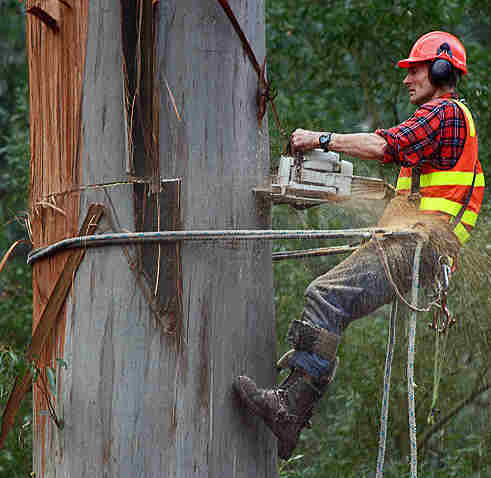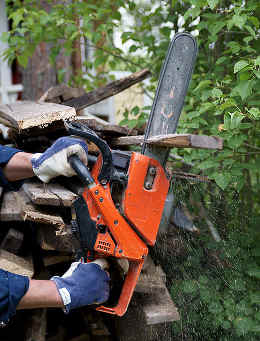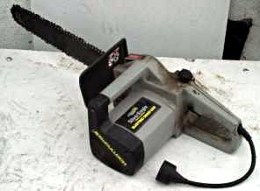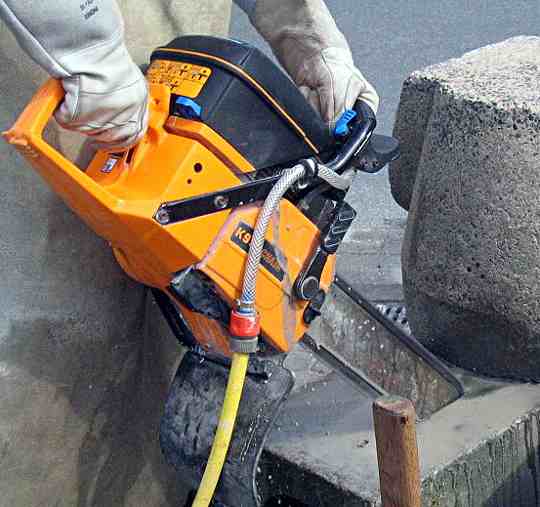 |
|||||||||||||
Graphical Construction Glossary >> Tools. >> Power Tools >> Chain Saw
What a brilliant invention these were. The leap of mind to actually look at the existing technology of chain and sprocket and think about incorporating cutting facets.
For the most part these saws are driven by small two stroke petrol engines. The engine itself is a marvel of ingenuity in that most other engines have to operate in place with only a small amount of movement allowed. The chainsaw however can operate sideways and almost upside down, depending on the position of the material being cut. It is so good at doing what it does that dozens of other small machines use these engines. On the right is a small shot of an electric saw. At first thought one might think that they would be a bit of a waste of time but think again. I have noticed on quite a few formwork sites where the guys are using 100mm and 150mm (4" and 6") timber that the chainsaw is the preferred saw to lop these timber to length. Also I have seen them used selectively on demolition work. I have used these saws now and again, on hire to do specific jobs. I think that hire saws have a hard life because people tend to push them too much when they start to get dull. The average hirer does not have a clue how to sharpen a chain and so they abuse the machine when the cutters gets dull. Using a dull saw is not only damaging the machine, but for safety reasons a sharp saw is a safer saw. There are heaps of instructions on the web for sharpening chains, but really for a one off job it is very simple. Get a round chainsaw file or rat tail file from your local hardware store the right size. Wipe the chain with an oily rag to clean off the main dirt then brush into the links etc to get it as clean as you can. Set it up somewhere solid. Leave the chain on the machine and just look at the teeth to see which way they go and place the saw-file into the front of the cutter just lightly resting in the compound angle that is already there. Give say two or three strokes to each tooth. You have to do one side first and then reposition the machine to do the other side. Wipe the saw with an oily rag to remove any metal swarf (filings) and then oil it thoroughly and check that it is not too loose. This I how I do a quick touch up on a hire saw but if I owned the saw I would follow the instruction manual. The main thing is if the saw is not cutting well do not press on. Stop and sharpen it of get it sharpened.
Chainsaw safety feature. Chainsaw cutting chain depth gauge. Safest operation of a chainsaw requires that the cutting chain is properly sharpened.
What we see here is a masonry cutting chain saw that is cutting using the wet method. The water is essential to keep the blade cool and it helps to flush the moving parts stopping the formation of what would be a blade destroying "grinding paste". If you didn't find exactly what you are looking for try this search tool that will search the site and the web. "What can be added to the happiness of a man who is in health, out of debt, and has a clear conscience? "When we build, let us think that we build for ever."John Ruskin 1819-1900 |
Hire Equipment  Furniture Fittings - Architectural Hardware - Electronic Locking Systems - Technical Hardware BuilderBill sponsorship Glossary Pages.Roof Glossary and Roofing Formwork Glossary and other tempory work. Hand Tools Glossary Power Tools Glossary Asbestos Glossary Woodwork Glossary Stair Glossary Concrete Glossary Masonry Glossary doors Glossary BuilderBill Books Building Maths  Stair Design  Asbestos Book |
||||||||||||
|
|
|||||||||||||
|
Please Note! The information on this site is offered as a guide only! When we are talking about areas where building regulations or safety regulations could exist,the information here could be wrong for your area. It could be out of date! Regulations breed faster than rabbits! You must check your own local conditions. Copyright © Bill Bradley 2007-2012. All rights reserved. |
|||||||||||||




